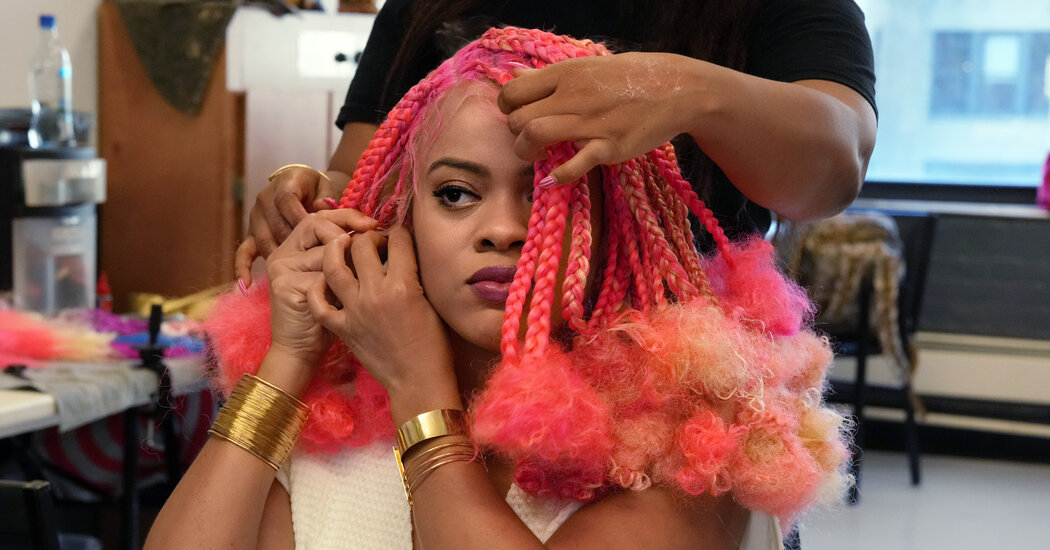
The styles in “Jaja’s African Hair Braiding,” in previews on Broadway, require a wig designer, several braiders, some synthetic hair and lots of patience.
Known for her amusing scripts and plaited hairstyles, Jocelyn Bioh can count only three times when she was without braids. “There’s a real freedom in getting your braids done,” she said. “Then you don’t have to worry about your hair for the next few weeks.”
The playwright’s lifelong commitment to interwoven hairdos inspired “Jaja’s African Hair Braiding,” a Broadway comedy about a day in the life of a hair braiding salon. It’s most likely the first Broadway play to shine a spotlight on Black women’s hair, and what it takes to style it.
Set in Central Harlem, around 125th Street and St. Nicholas Avenue (where many of these salons are clustered), “Jaja’s” presents a spirited group of West African hair stylists as their designs take shape and they juggle the uncertainties and perplexities of their new lives here. Because these women are rarely part of conversations about immigration, Bioh felt it was important for audiences to hear their stories.
In writing the play, Bioh (“Nollywood Dreams,” “School Girls; Or, The African Mean Girls Play”) sought to put a face to something that was likely to be unfamiliar to many theatergoers. “I want to take them into this really unique, funny, crazy, exciting, in some ways mundane space that holds women who all have incredible stories,” said Bioh, a native New Yorker whose parents emigrated from Ghana. “That’s what I’m trying to unpack in my play. What’s the other? What’s in the other?”
Alongside the comedy and drama, “Jaja’s” features a multitude of strand mastery, as Bioh and the director Whitney White (“Our Dear Dead Drug Lord”) were determined to show a range of hairdos coming to life onstage. To pull this off, most of these styles are executed in real time with a little stage magic courtesy of wigs constructed by the hair and wig designer Nikiya Mathis. Cast members, who braid hair onstage, practiced during rehearsals on wigs she designed for the performance.
“There are so many moving pieces to the show that involve hair, and it’s not just me backstage,” Mathis said. “It’s also the actors onstage, it’s what Jocelyn has written, and it’s what Whitney will be helping us to reveal.”
“Part of that,” she continued, “is going to be the magic of figuring out how we’re going to construct the wigs and how to potentially take them apart.”
The show is running about 90 minutes, without an intermission, yet these hairstyles can take anywhere from a couple of hours to a whole day to complete. There’s also the art of the craft. Creating a single braid starts with a cluster of hair: fingertips planted against the scalp, grasped at the roots of three sectioned tufts, deftly and repeatedly crocheted until a pattern emerges. The options are endless. The humble braid can stand alone, of course, but when woven loosely, it becomes the box braid. Woven against the scalp, it becomes the cornrow. Woven infinitesimally, it becomes the micro.
Building wigs that mimic these looks is labor intensive, and audiences are just beginning to see how the production, in previews at the Samuel J. Friedman Theater, pulls it off. This summer we followed along on the assembly and design of one of the flashier styles, a wig known as Jaja’s Strawberry-Swirl Knotless Afro-Pop Bob, worn by the actress Kalyne Coleman in the show.
Sew, Braid, Dye: One Wig, Many Hands
The wig-making process begins when a gallon-size poly bag is fitted on the actor’s head to make a mold. Once the measurements are taken and the hairline is drawn, the bag is removed, and the mold is filled with polyester fiber and placed on a canvas wig block. Lace is secured to the frame, which serves as the wig’s foundation, and finally strands of hair are sewn in one by one.
The show’s hair and wig designer, Nikiya Mathis, dyes the wigs in a solution of water and semi-permanent color. The more saturated the water is with dye, the deeper the pigment. She then agitates the hair to ensure all the strands attain the desired hue.
The hair design team builds the look together, with each stylist completing one braid at a time. Human hair is woven into the lace infrastructure, then small pieces of synthetic hair are added to give each braid length and fullness. More synthetic hair is bunched and teased at the ends of each braid to create volume for the puff.
Before the fitting, Kalyne Coleman’s real hair was braided into cornrows, which sit close to her head, so that the wig would fit over it easily. Then a stocking cap is placed over her head and secured with pins. The wig is then applied, and baby hair is pulled out. The edges are curled with gel to complete the look.
This post was originally published on this site be sure to check out more of their content.



